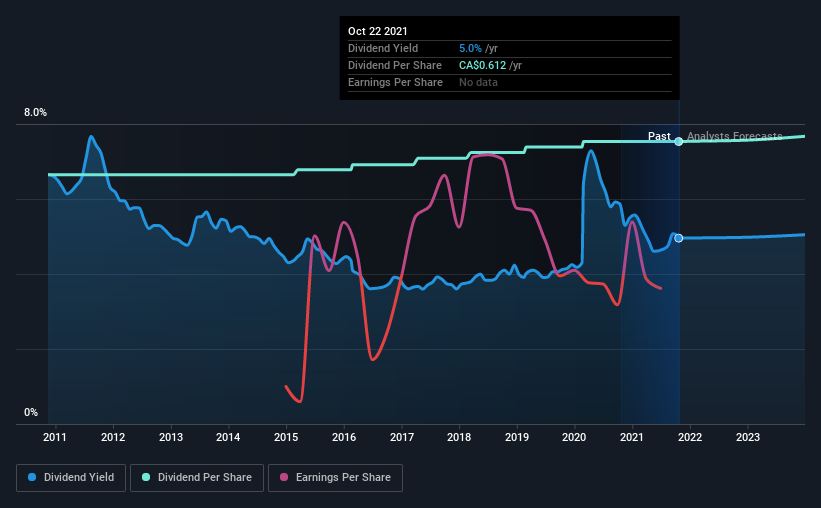We Wouldn't Be Too Quick To Buy Chartwell Retirement Residences (TSE:CSH.UN) Before It Goes Ex-Dividend
Chartwell Retirement Residences (TSE:CSH.UN) stock is about to trade ex-dividend in 4 days. The ex-dividend date is one business day before the record date, which is the cut-off date for shareholders to be present on the company's books to be eligible for a dividend payment. The ex-dividend date is an important date to be aware of as any purchase of the stock made on or after this date might mean a late settlement that doesn't show on the record date. Therefore, if you purchase Chartwell Retirement Residences' shares on or after the 28th of October, you won't be eligible to receive the dividend, when it is paid on the 15th of November.
The company's next dividend payment will be CA$0.051 per share, and in the last 12 months, the company paid a total of CA$0.61 per share. Based on the last year's worth of payments, Chartwell Retirement Residences stock has a trailing yield of around 5.0% on the current share price of CA$12.35. We love seeing companies pay a dividend, but it's also important to be sure that laying the golden eggs isn't going to kill our golden goose! That's why we should always check whether the dividend payments appear sustainable, and if the company is growing.
See our latest analysis for Chartwell Retirement Residences
Dividends are typically paid from company earnings. If a company pays more in dividends than it earned in profit, then the dividend could be unsustainable. Chartwell Retirement Residences reported a loss after tax last year, which means it's paying a dividend despite being unprofitable. While this might be a one-off event, this is unlikely to be sustainable in the long term. With the recent loss, it's important to check if the business generated enough cash to pay its dividend. If Chartwell Retirement Residences didn't generate enough cash to pay the dividend, then it must have either paid from cash in the bank or by borrowing money, neither of which is sustainable in the long term. Over the last year, it paid out more than three-quarters (76%) of its free cash flow generated, which is fairly high and may be starting to limit reinvestment in the business.
Click here to see the company's payout ratio, plus analyst estimates of its future dividends.
Have Earnings And Dividends Been Growing?
When earnings decline, dividend companies become much harder to analyse and own safely. Investors love dividends, so if earnings fall and the dividend is reduced, expect a stock to be sold off heavily at the same time. Chartwell Retirement Residences reported a loss last year, and the general trend suggests its earnings have also been declining in recent years, making us wonder if the dividend is at risk.
Another key way to measure a company's dividend prospects is by measuring its historical rate of dividend growth. In the last 10 years, Chartwell Retirement Residences has lifted its dividend by approximately 1.3% a year on average.
Remember, you can always get a snapshot of Chartwell Retirement Residences's financial health, by checking our visualisation of its financial health, here.
Final Takeaway
Is Chartwell Retirement Residences worth buying for its dividend? It's hard to get used to Chartwell Retirement Residences paying a dividend despite reporting a loss over the past year. At least the dividend was covered by free cash flow, however. Bottom line: Chartwell Retirement Residences has some unfortunate characteristics that we think could lead to sub-optimal outcomes for dividend investors.
Having said that, if you're looking at this stock without much concern for the dividend, you should still be familiar of the risks involved with Chartwell Retirement Residences. Be aware that Chartwell Retirement Residences is showing 3 warning signs in our investment analysis, and 1 of those shouldn't be ignored...
A common investment mistake is buying the first interesting stock you see. Here you can find a list of promising dividend stocks with a greater than 2% yield and an upcoming dividend.
This article by Simply Wall St is general in nature. We provide commentary based on historical data and analyst forecasts only using an unbiased methodology and our articles are not intended to be financial advice. It does not constitute a recommendation to buy or sell any stock, and does not take account of your objectives, or your financial situation. We aim to bring you long-term focused analysis driven by fundamental data. Note that our analysis may not factor in the latest price-sensitive company announcements or qualitative material. Simply Wall St has no position in any stocks mentioned.
Have feedback on this article? Concerned about the content? Get in touch with us directly. Alternatively, email editorial-team (at) simplywallst.com.

